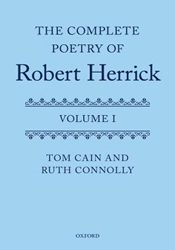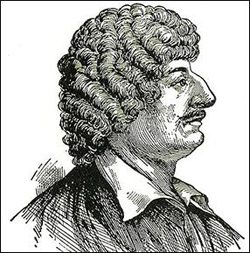
Without question The Complete Poetry of Robert Herrick is a milestone in the appreciation and recognition of one of the chief poets of delight among the English. The full work of a recognized master of the lyric form achieves due notice. I became entranced and inducted into a lifelong engagement with reading Robert Herrick’s poetry as a student of poet Tom Clark’s classes in Poetics at New College of California. Hearing Tom expound upon Herrick’s life and work opened new avenues of appreciation. As with so many other poets, such as John Keats, Tom truly brought the Herrick’s work to life.
I’ve never questioned the work’s sustained relevancy despite that Herrick’s reputation comes from a relatively few number of poems from out the phenomenal 1400 he composed. Many readers will be readily familiar with Herrick’s poetry. From “To the Virgins, To make Much of Time” as recited by the late Robin Williams in the film Dead Poets Society onwards to other regular anthology pieces such as “To Daffodils” or “Corinna’s Going A-Maying” Herrick’s lyrics are rather ubiquitously found as cultural reference points representing poetry-at-large. As a result, my focus here will not be upon individual poems so much as the editorial work performed and subsequent argument presented.
This two volume edition amply supplies the full range of available Herrick material. The first volume opens with a succinct biographical account, introducing Herrick’s life and work. The majority of the remaining 800+ pages contain Herrick’s sole publication in his lifetime of his entire 1400 poetic works. The poems appear as individual sequentially numbered entries, some titled some not, separated into two sections: the secular, larger Hesperides followed by the religious, slimmer His Noble Numbers. The religious nature of the latter section reflects Herrick’s time as a country pastor.
For contemporary readers there’s a fair amount of disjuncture between the two sections as numerous sexual and otherwise bawdy scenarios play out in the rather un-pastor-like first two-thirds of the book; yet for his time, Herrick’s role as a gentleman pastor who had his fair share of womanizing and drinking was rather par for the course. Published in 1648 when Herrick was fifty-seven, this single collection while nonetheless large is yet the extent of his work despite the fact he continued living until 1674. There’s a novel waiting to be written imagining the poet’s apparently ‘silent’ final twenty-six years of life.
The second volume includes generally brief annotations for individual poems as well as significantly enlarges critical approaches to Herrick’s work from the manuscript book level up. It’s a generous wealth of material, including musical settings for several poems made for Court performances possibly by the likes of Herrick’s friend the composer Henry Lawes: “evidence of three manuscript songbooks containing settings of Herrick’s work indicated that his lyrics were being performed in semi-public concerts in London in the late 1640s and early 1650s.”
Before printing presses really took off and books by individual poets were widely available, poems usually circulated as transcribed by hand into manuscript books known as “miscellanies.” Shared among acquaintances, numerous individuals might contribute entries as the book was passed round from gathering to gathering. This activity, as the editors suggest, was “a product, as Marjorie Swann has pointed out, of the humanist education system and its ‘notebook method’, which treated texts ‘as bundles of fragments which could be appropriated by readers and writers’.” Prior to the subsequent rise of the printing press, it played a predominant and central role in how a poet gained popularity and became known to a reading audience.
The editors make a clear argument that “recovery of Herrick’s manuscript career is essential to understanding what and how he wrote.” They untangle how Herrick’s appearance and rise in notoriety via the sharing of manuscript “miscellanies” opens the truest lens for better understanding his reasoning behind his presentation of his work when published. As the editors’ note “The often-commented-upon variety of Hesperides finds its reflection in the period’s verse miscellanies.” And they pointedly remark how “critical neglect of Herrick’s manuscript experience has led to this obvious resemblance and its significance being largely overlooked in the search for the model on which Hesperides was based.”
The thinking behind the arrangement and presentation of poems within Herrick’s only book becomes much clearer when understood as shaped by the times in which he was composing his poems, when there were no set examples of how to present a book of poetry other than their appearance in “these miscellanies”:
“The range of poems transcribed in these miscellanies encompasses lyrics, satires, epigrams, epitaphs, scriptuals, pastorals, translations, imitations of classical forms, and occasional verse, ordered at times according to a shared theme or tone but more often without any obvious organizing principle. Viewed from this perspective, Herrick’s decision to structure his volume as a miscellany does not seem peculiar but inevitable. This is how any collection of poems of comparable scope and variety is arranged in early Stuart manuscript literary culture and its translation into print suggests that Herrick did not see the change of medium as requiring any change in his book’s organization given that there was no effective difference between such a miscellany and a printed sylva.”
Like any other poet, New Criticism be damned, Herrick’s book is a product of his age. The poems reflect biographical facts of his life and the times in which he lived. The editors rightfully cite Herrick scholar Mary Hobbs assertion that Herrick “writes especially in the context of contemporary verse” before continuing on to note:
“His characteristic concern with a concise immediacy of expression, his use of evocative openings, and his willingness either to rest a poem on a single elegantly turned aphorism or to extravagantly pile up classical and scriptural allusions reflects his immersion in a literary environment, centered around universities and Inns of Court, that fostered these characteristics.”
The relatively well-off son of a Goldsmith who likely committed suicide, Herrick was looked after by his uncle who saw to it that he apprenticed as a Goldsmith but after a few years Herrick lost interest and sought an education at Cambridge. Though he started relatively late at the age of 22, “Herrick sustained a significant reputation at the university at least a decade after he left.” And “much of his work is stimulated by his university friendships.”
 An Appendix in the back of the first volume presents “Letters from Cambridge” which are the only extant prose documents in Herrick’s hand which are not formulaic in nature. However, as the editors’ note, there’s not much to get too excited about: “In terms both of their content, and of the biographical information that can be gleaned from them, the letters are disappointing.” In addition to these letters, “during research for this edition, another document in Herrick’s hand was discovered” yet it is only “his memorandum, the only one in his secretary hand, in the Goldsmiths’ Apprentice Book, dated 25 September 1607.” Otherwise, “all other surviving examples of Herrick’s hand are the fourteen signatures he put to documents prepared by others.”
An Appendix in the back of the first volume presents “Letters from Cambridge” which are the only extant prose documents in Herrick’s hand which are not formulaic in nature. However, as the editors’ note, there’s not much to get too excited about: “In terms both of their content, and of the biographical information that can be gleaned from them, the letters are disappointing.” In addition to these letters, “during research for this edition, another document in Herrick’s hand was discovered” yet it is only “his memorandum, the only one in his secretary hand, in the Goldsmiths’ Apprentice Book, dated 25 September 1607.” Otherwise, “all other surviving examples of Herrick’s hand are the fourteen signatures he put to documents prepared by others.”
In the letters Herrick’s contacting his Uncle for cash advances while he pursues his studies at St John’s College in Cambridge. These are requests to borrow against the capital of his inheritance, and in one case, for a loan on behalf of his brother. There’s evidence that as Herrick pursued his studies of the classics he also kept up a steady amount of inspired night time activity drinking and cajoling at inns and other local establishments. “An imitation of a Horation Ode” for instance “describes a personal drinking circle” and his drinking partners at these venues were “the kind of audience for whom Herrick was composing”, “the humanist-educated, Latinate university fellows who might be expected to identify the numerous, often subtle, usually playful, scriptual, classical, and vernacular allusions that saturate Herrick’s verse.”
The crowds in which Herrick circulated his work were in part found in the pubs and were otherwise readers of the “miscellanies”, in both cases, his “peers consistently demonstrate a preference for the brief, witty, allusive piece that could be endlessly recycled and ‘reset.'” Writing was seen as a game of sorts at which Herrick consistently proves he is quite adept. His “ability to compactly summarize the motifs and metaphors of any lyric subgenre but imagine them through a perspective that privileges miniaturization and fragmentation is a distinctive response, as yet critically unexplored, to this unique set of expectations.”
This sumptuous presentation of manuscript material alongside all of Herrick’s ridiculously wonderful poems leaves little doubt that future critics and readers will further tackle reading Herrick against the backdrop of his environment and peer-audience. Of course, this should be done while also keeping in mind the proper atmospherics suggested by the poet himself in “When he would have his verses be read”:
In sober mornings, doe not thou rehearse
The holy incantation of a verse;
But when that men have both well drunke, and fed,
Let my Enchantments then be sung, or read.




